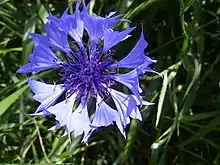The Broken Cornflower badge (Estonian: Murtud Rukkilille märk) is a badge given by the Estonian Minister of Justice to persons repressed by the occupying regimes or persons equated a repressed person,[1] in particular the ones repressed during the Soviet occupation of Estonia. It was introduced by President Lennart Meri in 2001 and the procedure of issuing the badges was formalized in 2004. The badge gives no additional preferences or benefits.[2]
History
The badge was designed by Heinz Valk.[3]
The cornflower is one of the national symbols of Estonia and the broken cornflower symbolizes the repression of Estonians.[4] After the June coup of 1940 many patriots wore a cornflower, because it became dangerous to wear badges or ribbons in national colors.[3]
The public association of the cornflower with mass deportations was made even before Estonia restoring its independence.[5] On June 14, 1990 (the anniversary of the June deportation) the memorial "Cornflower" was unveiled by the "Memento" society in the center of Tartu, based on the design of Paul Saar, "Cornflower on Siberian Rocks".[6]
In 2001, during the events commemorating the Soviet occupation, Lennart Meri gave away several thousand badges and three thousand more eligible people who were unable to take part in the events, received the badge from municipal leaders.[7]
Description
The badge is made of silver-plated copper, circular, 14 mm in diameter with a pin on the back. It displays a cornflower flower with three blue petals on a broken stem in metallic color. It is attached to a blue-black-white polyester fiber ribbon of length 11 cm in length and width 1 cm.[2]
References
- ↑ Okupatsioonirežiimide poolt represseeritud isiku seadus, Chapter 3
- 1 2 Murtud Rukkilille märgi andmise ning kandmise kord ja Murtud Rukkilille märgi kirjeldus
- 1 2 Elvi Pirk, Murtud rukkilill ja Murtud nelk (Broken Cornflower and Broken Carnation ), delfi.ee, June 10, 2001
- ↑ Murtud Rukkilille Ühingu tegevusest, Estonian World Review, April 16, 2003
- ↑ Ene Kõresaar, Terje Anepaio, Indiviidi rollist kodanikualgatuslikes mälestamispraktikates: stalinlike massirepressioonide komemoratsioon 21. sajandil, Eesti Rahva Muuseumi aastaraamat, Vol. 58, 2015, p. 75 (online view)
- ↑ Hando Kruuv: „Rukkilille“ monumendi loomine, Tartu Memento society
- ↑ Vabariigi Presidendilt sai Murtud Rukkilille märgi 10 000 võõrvõimu ohvrit ( 10,000 victims of foreign rule received the Broken Flower badge from the President of the Republic), Press service of the President's office
